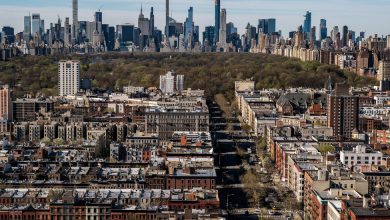162,000 Signs That New York Is Struggling to Bounce Back

Good morning. It’s Monday. Today we’ll look at why the pandemic job losses in New York City have lasted longer than anywhere in the United States.

Credit…Jeenah Moon for The New York Times
It’s a staggering number, even for New York City — 162,000, more than the population of Boulder, Colo., or Lancaster, Pa. It’s the number of jobs that the city is missing as it continues the struggle to move beyond the pandemic and into an early chapter of a very different future.
Since the early months of the pandemic, New York has had the slowest jobs recovery of any major metropolitan area. If there’s a bright spot, it is this: The number of jobs that the city lost in August was about 14,000 fewer than the number from just a month before, and hiring in many industries has accelerated over the past year.
I asked my colleague Nicole Hong, who with Matthew Haag has been covering the lingering economic effects of the pandemic, to explain.
The rest of the country has recovered all of the jobs it lost during the pandemic. Why have jobs been slower to rebound in New York than anywhere else?
As the epicenter of the virus early in the pandemic, New York City lost almost one million jobs in the first two months, the most of any city, so it had much further to go to recover. New York is also disproportionately reliant on heavy foot traffic and spending by office commuters and tourists, both of whom vanished virtually overnight in March 2020 when the pandemic hit.
The severity of the public health crisis here meant that New York had longer lockdowns and more stringent vaccine mandates than many other cities, which came with their own economic costs.
But many employers now say they can’t find workers, especially for jobs that can’t be done remotely. Why not?
First of all, the work force in New York City is much smaller than it was in February 2020, so that’s contributing to the labor shortage. The pandemic prompted a lot of workers to retire early or move out of the city.
When I interviewed workers here who lost their jobs early in the pandemic and were still unemployed, they shared a wide variety of reasons for being pickier in their job search now. Child care is a big one. Some single mothers are prioritizing finding a job closer to their children’s schools because the pandemic has been so disruptive to in-person schooling and has required more frequent pickups.
Others are quitting jobs where they decided the commutes were too long. And we also spoke to people who refused to be vaccinated and were unable to work certain in-person jobs that had employer vaccine mandates.
You write that things don’t look good for job growth in hotels and restaurants. How does that tie in with expectations for tourism, which was a big part of the city’s economy before the pandemic?
If you walk around Times Square, it definitely feels like the tourists are completely back. But the mix of visitors is different. Levels of business and international travel are still lower than they were before the pandemic, which is a problem for New York’s economy because those visitors tended to stay longer and spend a lot more money than domestic visitors or regional day-trippers.
So it’s not surprising that a majority of the jobs lost in the private sector were in the hospitality and retailing industries.
That points to the lopsidedness of New York’s recovery. Hospitality and retailing have long been a way for younger people, immigrants and residents who don’t have college degrees to enter the work force.
Those segments of the economy also tend to provide little opportunity for remote work. By contrast, employment in industries that allow people to work remotely, like the technology sector, is back at prepandemic levels. Until this month, white-collar workers in New York have been slower to go back to their desks than in other cities around the country.
The number of office workers back at their desks seems to be creeping up slowly — last week the Partnership for New York City said 49 percent of Manhattan office workers were in their workplaces at least one day a week. That was up from 38 percent in April. But you spotlighted the ripple effects on people who aren’t covered in the Partnership’s surveys.
All of the survey data shows that workers overwhelmingly want more flexibility in their schedules, and the persistence of hybrid work may be a permanent shift that emerges from the pandemic.
However, there’s a consequence to a workweek where commuters are only coming in for part of the time. We spoke to an office cleaner who only recently got his job back because empty buildings don’t need as many cleaners. There are thousands of workers like him whose livelihoods depend on office buildings.
So one key challenge for the city moving forward is making sure those workers access the same opportunities to transition to new careers or develop new skills.
Mayor Eric Adams has often described returning to the office as an equity issue, arguing that many lower-income jobs depend on white-collar workers showing up at their offices. He has publicly scolded office workers who don’t. He famously disparaged them for staying “home in your pajamas all day.” Last week he said that remote work was worsening the city’s income divide. But some lawmakers say the lack of a hybrid option for city government workers, an option he could allow, has contributed to an exodus of municipal employees and slowed the delivery of basic services.
Weather
A partly sunny day with highs in the mid-80s and a chance of a storm in the afternoon. Tonight will be cloudy with lows in the 70s.
ALTERNATE-SIDE PARKING
In effect until Sept. 26 (Rosh Hashana).
U.N. GENERAL ASSEMBLY
The city Department of Transportation has declared every day this week a “gridlock alert day.” Expect street closings, detours, unannounced traffic freezes and frustration as the United Nations General Assembly convenes with in-person attendance after two years of pandemic restrictions.
The latest Metro news
Crime
-
Coney Island drowning: After three children were found dead on the shore of Coney Island, their mother was charged with murder while being evaluated in a psychiatric facility in Brooklyn.
-
Bronx stabbing: The stabbing of a 35-year-old man who was sitting his car in July — an attack that police officials say was unprovoked — continues to rattle the Bronx neighborhood of Norwood.
Other News
-
A pause for all: Yeshiva University, ordered by the Supreme Court to recognize an L.G.B.T.Q. student group, instead placed all undergraduate club activities on hold.
-
No longer an app for that: The supermarket chain Wegmans has discontinued its self-checkout app, which let customers scan their groceries as they shopped. The company cited losses but did not say whether they were from customers who simply forgot to scan some items.
Arts and Culture
-
Broadway after “Phantom”:With “Phantom of the Opera” closing in February after 35 years and 13,925 performances, which shows will become the longest-running?
-
Point of no return: The producer Cameron Mackintosh said that a weakening box office and rising production costs led to the decision to close “Phantom of the Opera.”
-
You’ve got disco mail:Mail sorter by day and dance-music producer at night, Richie Weeks has had 30 years of a double life spinning tracks.
-
MoMA curator departs:After two years as the chief curator of photography at the Museum of Modern Art, Clément Chéroux is leaving.
METROPOLITAN diary
Table Talk
Dear Diary:
It was January 2010, and my husband had made a reservation at a small French restaurant on the Upper East Side to celebrate my birthday.
The tables are very close together, and we started chatting with a man and a woman who were sitting next to us.
I love to share good news, so I told them it was my birthday and that after dinner we were headed to see Laura Linney in “Time Stands Still.”
The man asked whether we had seen “South Pacific” at Lincoln Center.
I said that, sadly, we had not. We were not Lincoln Center members although we wanted to be. There was a wait.
The woman he was with spoke up.
“Tonight is your lucky night,” she said. “You don’t know who you’re sitting next to.”
The man gave me his business card and asked me to write my email address on it with some dates when we were available to see “South Pacific.”
I was confused but did as he requested. He told me to keep an eye on my inbox. He did not offer any more information, and I did not ask any questions.
After they left, I asked the waiter if he knew who the man was.
Of course, he said, that was André Bishop, Lincoln Center Theater’s artistic director.
We saw “South Pacific” on Valentine’s Day in house seats.
— Ilene Whitman
Illustrated by Agnes Lee. Send submissions here and read more Metropolitan Diary here.
Glad we could get together here. See you tomorrow. — J.B.
P.S. Here’s today’s Mini Crossword and Spelling Bee. You can find all our puzzles here.
Fariha Rahman and Ed Shanahan contributed to New York Today. You can reach the team at [email protected].
.




